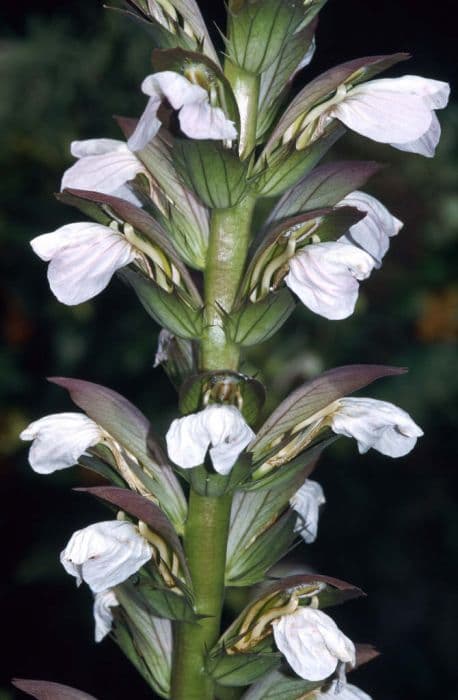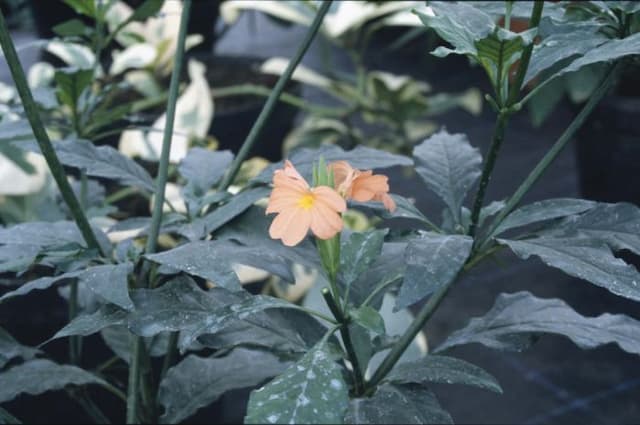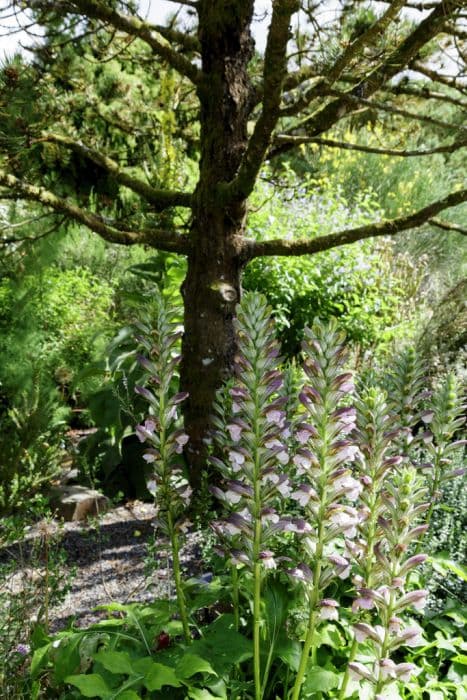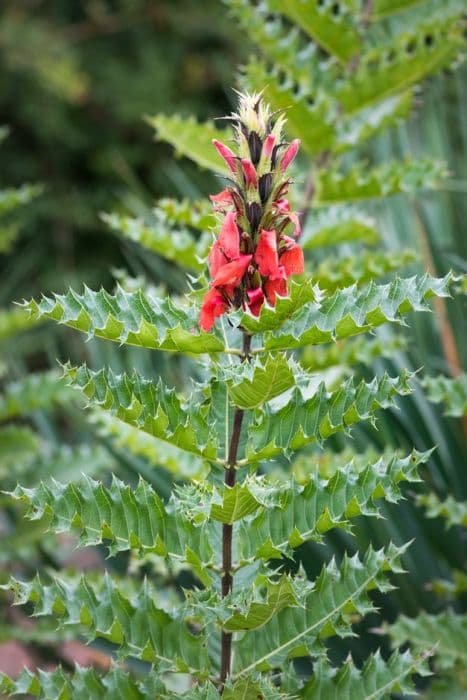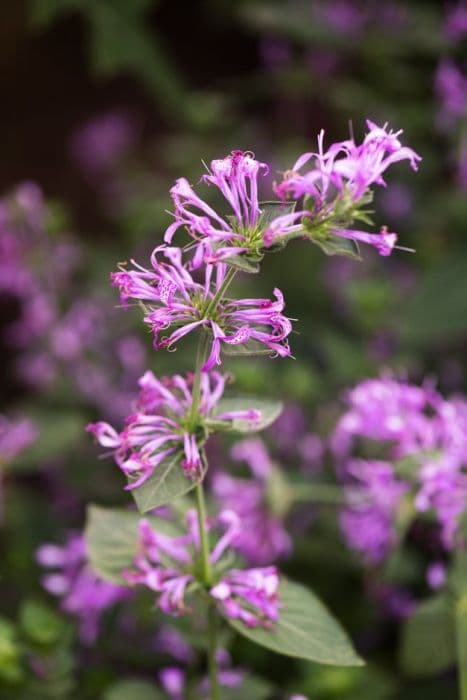Black-eyed Susan vine Thunbergia alata 'African Sunset'
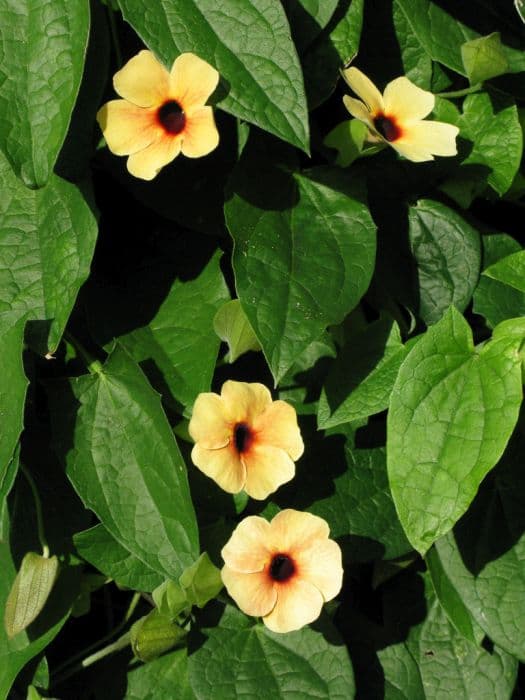
ABOUT
The African Sunset variety of Black-eyed Susan vine features a captivating array of warm-toned blooms, with flowers that display a spectrum of colors ranging from deep orange to salmon and rich, reddish-brown, often with subtle hints of peach. Each flower has a characteristic dark center, which looks like an eye, lending to its common name. The petals radiate outwards in a five-pointed star shape, giving the blossoms a delicate yet simple aesthetic. The vine itself possesses heart-shaped leaves that offer a lush green backdrop to the stunning flowers. These leaves are arranged alternately along the vine's length, creating a full, verdant appearance. As a climbing plant, African Sunset is often found twisting around supports, with its tendrils grabbing onto structures, other plants, or trellises. The overall result is an enchanting, rustic charm that can add a pop of color to gardens, balconies, or as part of a floral arrangement.
About this plant
 Names
NamesFamily
Acanthaceae
Synonyms
Black-Eyed Susan Vine, Clock Vine, African Sunset
Common names
Thunbergia alata 'African Sunset'.
 Toxicity
ToxicityTo humans
Black-eyed Susan vine is not commonly listed as a toxic plant to humans. While it is generally considered non-toxic, it is still not advisable to ingest any part of this ornamental plant due to the potential for allergic reactions or gastrointestinal upset in sensitive individuals. If someone were to consume parts of the plant, monitoring for any adverse reactions and consulting a medical professional is recommended.
To pets
Black-eyed Susan vine is also not widely recognized as a toxic plant to pets. Although it may not be specifically listed as poisonous, it is generally wise to prevent pets from ingesting this or any ornamental plants, as they could cause mild stomach upset or an allergic reaction. If a pet does consume some of the plant, it is advisable to observe them for signs of discomfort and to consult with a veterinarian if any concerning symptoms arise.
 Characteristics
CharacteristicsLife cycle
Annuals
Foliage type
Deciduous
Color of leaves
Green
Flower color
Mixed
Height
6-8 feet (1.8-2.4 meters)
Spread
3-6 feet (0.9-1.8 meters)
Plant type
Climber
Hardiness zones
10
Native area
Eastern Africa
Benefits
 General Benefits
General Benefits- Attracts pollinators: The vibrant flowers of Black-eyed Susan vine entice bees, butterflies, and other beneficial pollinators to the garden, aiding in the pollination of nearby plants.
- Aesthetic appeal: With its bright, colorful blooms, it adds a stunning visual interest to any garden, balcony, or indoor space.
- Easy to grow: This plant is known for being low-maintenance and easy to grow, making it suitable for gardeners of all skill levels.
- Versatile: Black-eyed Susan vine can be grown in containers, hanging baskets, or as a groundcover, as well as trained up trellises or fences.
- Fast-growing: It is a fast-growing plant that quickly covers trellises or other supports, providing a lush, green backdrop with pops of color.
- Privacy: When grown on fences or trellises, it can act as a natural privacy screen while also beautifying the area.
- Seasonal interest: This plant typically flowers from early summer to fall, offering long-lasting seasonal interest in the garden or landscape.
 Medical Properties
Medical PropertiesThis plant is not used for medical purposes.
 Air-purifying Qualities
Air-purifying QualitiesThis plant is not specifically known for air purifying qualities.
 Other Uses
Other Uses- Natural dye: The flowers of Black-eyed Susan vine can be used to create a natural yellow-orange dye for fabrics or paper.
- Photography subject: The vibrant colors and unique appearance of Black-eyed Susan vine make it a popular subject for photographers, especially in macro photography.
- Butterfly garden addition: Black-eyed Susan vine can attract butterflies and hummingbirds, enhancing the biodiversity of a garden.
- Artistic inspiration: Artists can use the beauty of the Black-eyed Susan vine as inspiration for paintings, drawings, and other artworks.
- Privacy screen: When grown on fences or trellises, Black-eyed Susan vine can serve as a natural privacy screen for patios or decks.
- Learning tool: Black-eyed Susan vines can be used in educational settings to teach about climbing plant species and pollination.
- Culinary decoration: Edible flowers of certain cultivars can be used to decorate salads or desserts for an appealing visual flair.
- Theme gardens: Black-eyed Susan vine can be a central theme in a garden focused on sunset colors or African-inspired landscapes.
- Wedding decor: Fresh or dried, the blooms and vines can be used in floral arrangements or as decor for weddings and events.
- Greening urban spaces: In cities or areas with limited green space, Black-eyed Susan vines can add a touch of nature to balconies and small gardens.
Interesting Facts
 Feng Shui
Feng ShuiThe Black-eyed Susan vine is not used in Feng Shui practice.
 Zodiac Sign Compitability
Zodiac Sign CompitabilityThe Black-eyed Susan vine is not used in astrology practice.
 Plant Symbolism
Plant Symbolism- Enduring Love: Thunbergia alata, commonly known as Black-eyed Susan Vine, often symbolizes an affection that is long-lasting due to the plant's vigorous and persistent growth habit.
- Encouragement: Its bright and cheerful flowers can represent encouragement and motivation, often given to someone who needs a reminder of the happiness in life.
- Strength: The hardiness of the Black-eyed Susan Vine and its ability to climb and adapt to various conditions symbolizes strength and resilience in the face of adversity.
- Unity: The twining nature of the vine, which allows it to grow in conjunction with other plants, represents the idea of unity and supporting one another.
 Water
WaterThe Black-eyed Susan vine should be watered when the top inch of soil feels dry. This vine enjoys moist, well-drained soil and does not like to be waterlogged, so allow the soil to dry slightly between waterings. Water thoroughly until excess water drains out the bottom of the container. In terms of frequency, this may translate to watering once every week, but this can vary depending on environmental factors like heat and humidity. Typically, using about half a gallon of water every seven days during the growing season is sufficient, but adjust as needed for your climate and the plant's response.
 Light
LightBlack-eyed Susan vine thrives in bright, indirect sunlight. It's best positioned in a spot where the plant will receive plenty of light but be shielded from the harsh midday sun. If growing indoors, a window with southern or western exposure is ideal, ensuring the vine gets at least six hours of sunlight daily.
 Temperature
TemperatureBlack-eyed Susan vines prefer temperatures between 60°F and 85°F. They can survive minimum temperatures of around 50°F, but growth will be reduced, and they should not be subjected to temperatures below this threshold. The vines are not frost-tolerant and will not survive freezing conditions. During the growing season, maintaining an environment within their ideal temperature range will promote healthy growth.
 Pruning
PruningPruning the Black-eyed Susan vine is necessary to maintain shape, encourage bushier growth, and remove any dead or diseased foliage. Prune lightly throughout the growing season as needed. The best time for more substantial pruning is in the spring before new growth begins. Cut back the vine to help rejuvenate the plant and encourage fresh, vigorous growth.
 Cleaning
CleaningAs needed
 Soil
SoilBlack-eyed Susan vine (Thunbergia alata 'African Sunset') thrives in a well-draining soil mix rich in organic matter, such as a blend of peat, compost, perlite, and pine bark. The ideal soil pH should be between 6.0 to 7.5, slightly acidic to neutral.
 Repotting
RepottingBlack-eyed Susan vine should be repotted every 1-2 years or when it becomes root-bound. Choose a pot that is one size larger than the current one to allow for growth.
 Humidity & Misting
Humidity & MistingBlack-eyed Susan vine prefers moderate to high humidity levels, ideally between 40-60%. Mist regularly or use a pebble tray to increase ambient humidity.
 Suitable locations
Suitable locationsIndoor
Provide bright indirect light and trellis support.
Outdoor
Plant in partial shade with support to climb.
Hardiness zone
10-11 USDA
 Life cycle
Life cycleCommonly known as Black-eyed Susan vine, Thunbergia alata 'African Sunset' begins its life cycle when seeds are sown in warm, moist soil in early spring or started indoors before the last frost. Seedlings emerge in 7-14 days, revealing pairs of heart-shaped green leaves as they grow, requiring plenty of light. After transplanting when the threat of frost has passed, the plant experiences a rapid vegetative growth stage, developing long twining stems that require support for climbing. The flowering stage usually occurs in the early summer, showcasing its vibrant orange to red flowers with dark centers, attracting pollinators such as bees and butterflies. Following pollination, the plant produces small, round seed pods, which mature and release seeds, completing the reproductive stage of its life cycle. In temperate climates, Black-eyed Susan vine is treated as an annual plant and will die once frost occurs, but in warmer zones, it may survive as a perennial, going dormant in winter and returning in spring.
 Propogation
PropogationPropogation time
Spring-Early Summer
The most popular method of propagating the Black-eyed Susan vine, or Thunbergia alata 'African Sunset', is through seed. To propagate by seed, plant the seeds in spring after the last frost has passed, when the soil has warmed up. Use a well-draining seed starting mix and sow the seeds about 1/4 inch deep (6 mm). Keep the soil moist but not waterlogged and place in a warm, bright spot without direct sunlight until germination, which typically occurs within 7-14 days. Once the seedlings have grown and the threat of frost has passed, they can be transplanted outdoors to a location that provides ample sunlight and good air circulation.





